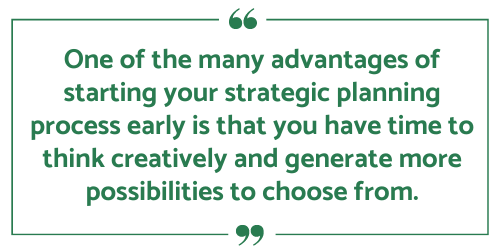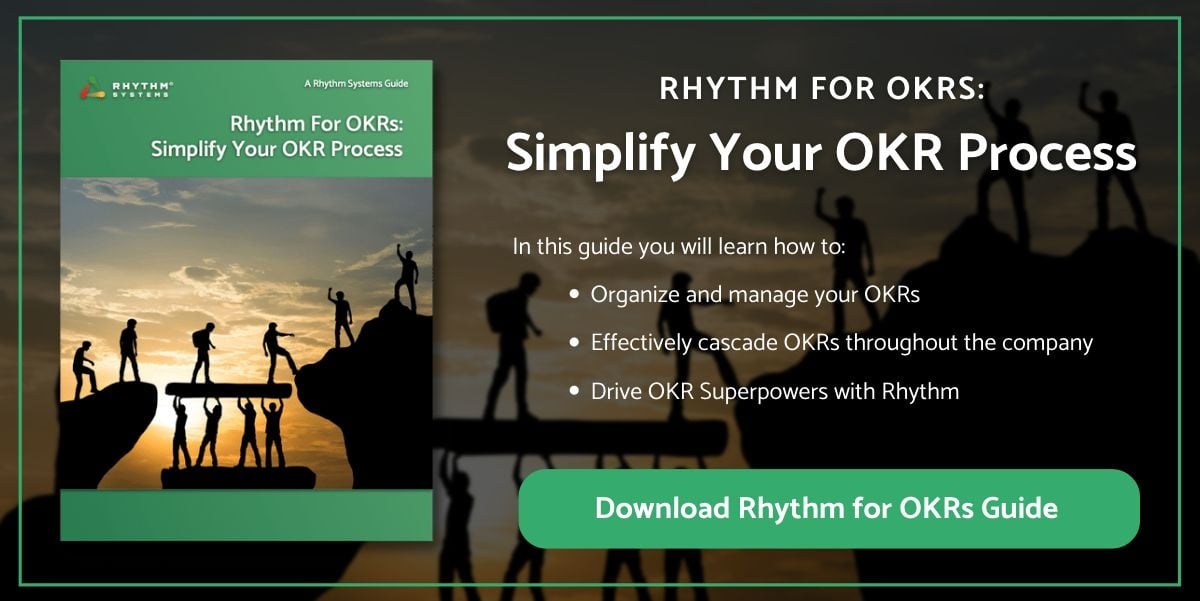Leadership OKRs are a reliable way to connect workers to the company's mission and shared vision. Through this structure, managers can set clear goals that are challenging yet attainable, ambitious but quantifiable, and motivate employees to work towards a collective objective. The OKR approach is an outcome-based leadership technique frequently employed by nimble companies to link the organization's ambitions with every team member. Additionally, it assists in erasing barriers between different departments and teams across the company.
Leaders across departments have specific roles when creating OKRs, with objectives reflecting results relevant to their teams and business areas. These examples can be used as a starting point for leaders looking to create their own set of objectives and key results that will help drive success in their organization. With these examples, leaders can ensure they set achievable goals that will motivate their team members while pushing them to reach higher performance levels.

OKR Examples for Managers
Top management OKRs are a great way for leadership teams to ensure their goals and objectives align with the organization's overall mission. By setting clear, measurable objectives and key results, top management can ensure that everyone in the organization is working towards the same goal. This helps to create an environment of collaboration and accountability and provides a framework for assessing progress and making adjustments when properly tracked with OKR software.
The OKR framework also allows leaders to be transparent and authentic while managing goals better, assessing metrics, and steering the focus toward deriving maximum advantage. With OKRs, leaders can develop a powerful business strategy to increase growth, expand operations to three new offices while improving brand image among employees and customers, or increase annual recurring revenue from a new line of business. By setting these specific objectives with measurable results, top management can ensure that everyone in the organization is on the same page when they set OKRs and work together towards achieving success.
OKR Dos and Don'ts
The OKR model, or Objectives and Key Results, is a powerful tool for setting goals and measuring progress. They provide a framework for teams to focus on driving specific results while still allowing room for creativity and innovation. OKRs can help organizations achieve their objectives more efficiently and effectively when used correctly. High-performing organizations can accelerate and scale more quickly when aligned with company goals.
Keeping OKRs concise and focused on the desired outcome is important when creating them. Setting aspirational goals and challenging teams and individuals is also key to getting the most out of OKRs. It is also important to avoid being overly prescriptive or including too many details, as this can lead to confusion and lack of clarity. OKRs are suitable for all members of an organization, from the CEO to the intern. Still, they benefit companies focused on growth who want to innovate, outshine competitors, and execute more efficiently. By following these dos and don’ts when creating OKRs, organizations can ensure they get the most out of this powerful goal-setting tool.
Defining Great Key Results
Key Results are an important part of any business strategy. They provide a way to measure progress and success toward achieving an objective. Key Results must be measurable, specific, and achievable in order to be effective. Examples of great Key Results include:
- Increasing customer retention.
- Launching a new CRM by a certain date.
- Increasing checkout flow conversions by 40%.
- Attending three networking events this quarter.
- Writing and publishing one blog post per week.
These types of Key Results are great because they provide clear goals that can be tracked over time. They also help to ensure that the objectives set out in the business strategy are being met in a timely manner. Additionally, they can help identify areas where improvement is needed or additional resources may be necessary. By setting clear Key Results, businesses can ensure that their strategies remain on track and their goals are achieved.

Leadership OKR Example Writing Tips
Objectives, key results, and tasks are all important components of an effective OKR. Objectives are the goals that need to be achieved, while key results are the outcomes that will measure success. Tasks are the actions taken to reach those objectives. The OKR formula is a helpful way to structure objectives and key results: I will __________ (objective), as measured by __________ (key result). Writing quantitative, specific key results drives focused execution and defines the success of an objective.
When writing team OKRs, involving everyone in the discussion process is essential. This helps ensure that everyone is on the same page regarding understanding what needs to be accomplished and how it can be done. After discussing the objectives and key results, initiatives should be identified which link them together for alignment. This helps keep everyone focused on their tasks while also working towards a common goal. By following these tips for writing effective OKRs, teams can ensure they
Leadership OKR Example Tip #1: Choose between 3-5 objectives
Setting objectives is an important part of any successful business. It helps to provide focus and direction and measure progress toward achieving goals. When setting objectives, it’s important to choose between 3-5 objectives that are achievable within a given timeframe. This will help teams better manage their targets and ensure they work towards the right goals.
When creating objectives, teams should send their prioritized list of problems and issues to ensure that the goals are clear and leave no room for interpretation. Additionally, teams should design and write key results which should be time-bound, specific, and include a number. Assigning a Key Results champion to monitor and lead weekly/monthly OKR check-in meetings can also help keep teams on track with their goals. Finally, it’s important to remember that each objective should have 3-5 key results associated with it in order to maximize efficiency and productivity. By following these tips, businesses can ensure what they are setting.
Leadership OKR Example Tip #2: Choose between 3-5 key results per objective
When setting objectives and key results, teams should be mindful of the number of key results they choose. It is recommended that teams select between three and five key results per objective. This will help ensure that each objective is achievable and measurable.
The team should also design and write the key results as they are the subject-matter experts and owners of the work. Each key result should be time-bound and specific and include a number to track progress easily. Assign a Key Results champion to monitor and lead weekly/monthly OKR check-in meetings to ensure success.
Additionally, aim for quarterly objectives to manage targets more easily. Encourage teams to send their prioritized list of problems and issues so that objectives leave no room for interpretation. By following these tips, teams can set clear objectives with measurable goals that will help them efficiently reach their desired outcomes; for more information on how to implement OKRs in an organization.
Leadership OKR Sales Examples
The sales team at this company has set some ambitious goals for themselves. Their first goal is to grow year-over-year sales by 65%, totaling $1.65 million in sales. To achieve this, they plan to exceed their quarterly sales quota by 50%, booking 40 new client meetings and achieving 20 new SQLs. They also plan to increase sales from new customers by 75% and grow recurring customer revenue by 30%.
In addition, the team plans to increase average contract value/deal size/cart value by 20% through greater sales effort on leads from larger, deeper-pocketed clients and implementing new sales scripts and website automation. They also want to improve their presence in a new market by 200%, hiring ten localized sales representatives, reaching 100 new prospects with one-to-one meetings, and onboarding two regional resellers. Finally, they hope to bring in $25,000 in cross-sell revenue by selling the most expensive add-on.
Leadership Marketing OKR Examples
The marketing team at this company has set some ambitious OKRs to help them reach their goals. Their first objective is to launch a rebrand and increase their Net Promoter Score (NPS) from 30 to 45 or better. This will involve creating a new brand identity, developing marketing materials, and engaging customers to get feedback on the new look and feel.
Their second goal is to launch a podcast campaign with 5,000 subscribers in the first month. This will require careful planning and execution of an effective promotional strategy that reaches the right audience. Additionally, they want to improve customer retention and Customer Lifetime Value (CLV) by sharing 20 case studies and increasing email open rates from 40% to 60%. To do this, they must create compelling content that resonates with their target audience and optimize their emails for higher open rates. Finally, they plan on researching and prioritizing target keywords for SEO optimization, increasing website visitors and social media followers by 33% and
Customer Service Leadership OKR Examples
The customer delivery and service OKRs are focused on increasing customer retention, improving the Net Promoter Score, and creating a more efficient customer service process. The first goal is to conduct post-engagement debriefs for contracts above $50K and develop formal account reviews with strategic accounts. This will help ensure that customers are satisfied with their experience and will be more likely to return in the future. Additionally, the goal is to increase the Net Promoter Score from 6.5 to 7, indicating that customers are delighted with their experience.
The other goals focus on creating a more efficient customer service process. The goal is to create a running SOP document for customer service representatives to respond to inquiries and provide accurate information quickly. Additionally, the goal is to increase the 24-hour support ticket close rate from 60% to 90%, ensuring customers get timely responses and resolutions to their issues. Finally, there is also a goal of creating a monthly
Operational Excellence Leadership OKR Examples
Organizational OKRs are a great way to set a company-wide vision and ensure everyone is working towards the same goal. Examples of organization-wide OKRs include becoming the most delightful business in the market and the revenue leader in the region. Key results may include achieving a net promoter score greater than 8, achieving a customer retention rate of 90%, increasing five-star reviews by 25%, and increasing marketing-qualified leads by 25%. Additionally, organizations can strive for operational excellence by setting goals. Goals can include increasing average customer value (ACV) and customer satisfaction scores by 20%, hosting four open Q&A meetings to hear directly from employees, and reviewing and enhancing compensation and benefits packages to reach a +20% market average. By setting these goals, organizations can ensure they are consistently striving for operational excellence.
People/Human Resources Leadership Example OKRs
People expertise is an essential component of any successful organization. By offering bi-monthly professional development opportunities, quarterly check-ins, and at least one 8% raise each year for employees meeting their goals and objectives to the satisfaction of their supervisor, companies can ensure that their people are well-equipped to handle the challenges of today's business environment.
Objectives and Key Results (OKRs) are a great way to help teams focus on driving specific results instead of busy work. OKRs are suitable for all members of an organization, from CEO to intern, and they are particularly beneficial for companies focused on growth and innovation. Organizations can ensure that everyone is working towards the same goal by setting clear objectives and measurable key results. This helps create a culture of accountability and encourages collaboration between departments.
Engineering Leadership OKR Examples
Engineering OKRs are a great way to ensure teams focus on the right goals and objectives. By setting ambitious goals, engineering teams can ensure they work towards the best possible customer outcomes. For example, reducing customer-reported bug tasks after major launches by finding 30-50 volunteers to test features before launch and decreasing the time to fix critical bugs in production from 24 hours to 16 hours is an ambitious goal that will help improve customer satisfaction. Additionally, implementing Agile management across the engineering team, piloting a test project for individual feedback and results, and automating performance reporting help streamline processes and ensure engineers focus on the most critical tasks.
In addition to setting ambitious goals, engineering teams must focus on optimizing and reducing bottlenecks. This means hiring seven engineers, improving response time from 20 to ten minutes, and auditing non-critical meetings on the team calendar every two weeks. Outcome-based
Human Resources OKR Leadership Examples
The Human Resources department ensures that employees are engaged, productive, and satisfied. To achieve this goal, the HR team must set clear objectives and key results (OKRs) to measure their progress. Examples of OKRs for the Human Resources department include developing 5-7 training materials to build interview skills, decreasing help tickets from 20% to 8%, launching five career roadmaps every month and maintaining an employee retention rate above 80%, launching an ongoing 2-way closed-loop feedback process to create clarity of all departments and teams via clear OKR goals, improving employee engagement score and employee satisfaction to 8 or above, providing consistent training to managers on how to manage effectively, doing monthly anonymous employee surveys, ensuring every manager is doing regular 1-on-1 meetings with 2-way feedback, transitioning to an ongoing performance management system, implementing 2-way closed-loop feedback with lite check-ins, and instituting quarterly performance reviews and annual summaries.
Why Great Team Leaders Use OKRs
- Leadership OKRs are a way to set clear goals that motivate employees, foster collaboration, and empower them to lead purposefully. OKRs are a valuable tool for leaders to encourage employees toward collective objectives while ensuring that the employee knows what they are being measured on.
- By implementing top-level OKRs, leadership can better synchronize the organizational mission and goals with individual employee performance to break down communication barriers between departments. They should be aligned with the overall company objectives.
- Creating OKRs with clear, specific goals and measurable outcomes is essential. Top management OKRs focus on achieving the organization's mission while erasing barriers between departments and teams. Establishing measurable, attainable objectives and key results is vital for successful leadership.
- Monitoring Key Results is an essential element of any business strategy as it allows one to assess the progress and effectiveness in reaching an intended goal. This can be done with strategy execution software, such as Rhythm Systems strategy execution software, to document strategy, vision, goals, and projects and encourage collaboration.
If you think we might work well together, please drop us a line.
Learn more about OKRs from these popular articles:
- Ditch Your OKR Spreadsheet: Why You Should Upgrade Your OKR Software Game in 2023
- Best OKR System: How to Get Started with OKRs and the Best OKR Software
- OKR vs. KPI: What's the Difference Between OKRs and KPIs? (With Examples)
- How to Write OKRs A Step By Step Guide With Examples
- CEO OKRs: 5 Examples of Objectives and Key Results
Photo Credit: iStock by Getty Images



 LinkedIn
LinkedIn
 Facebook
Facebook

